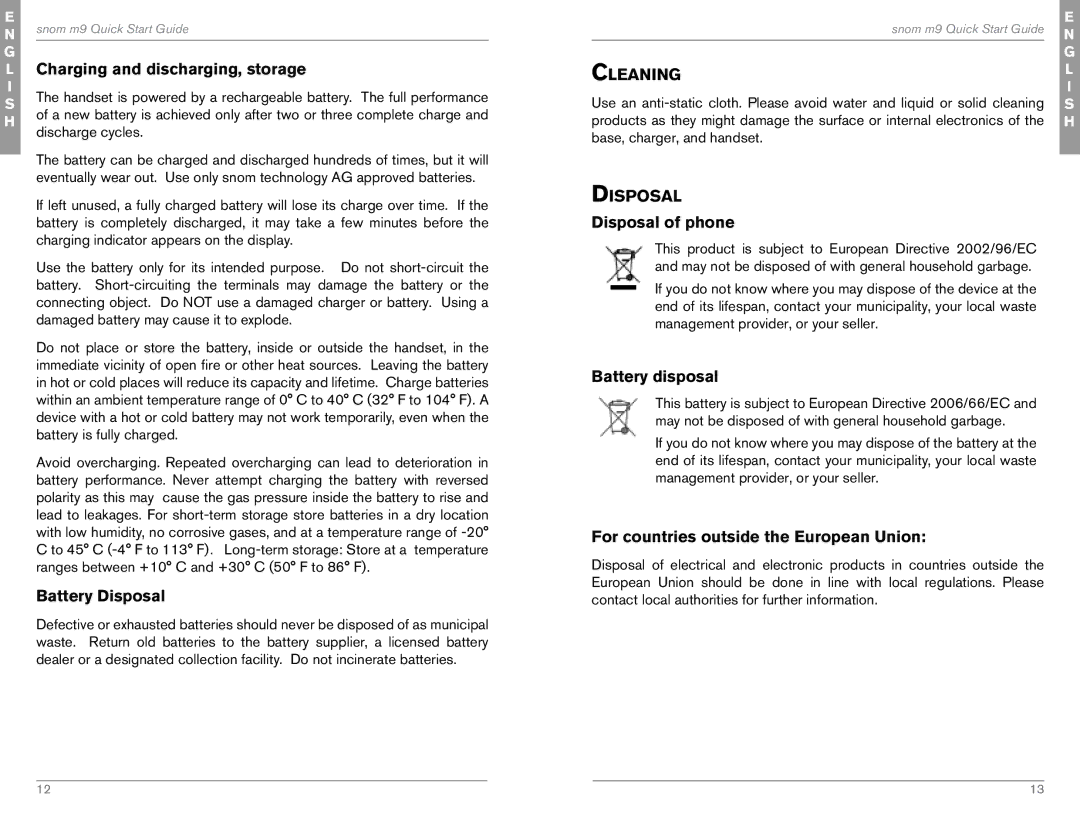E | snom m9 Quick Start Guide | ||
N | |||
|
| ||
G | Charging and discharging, storage | ||
L | |||
I | The handset is powered by a rechargeable battery. The full performance | ||
S | |||
of a new battery is achieved only after two or three complete charge and | |||
H | |||
discharge cycles. | |||
| |||
| The battery can be charged and discharged hundreds of times, but it will | ||
| |||
| eventually wear out. Use only snom technology AG approved batteries. | ||
| If left unused, a fully charged battery will lose its charge over time. If the | ||
| battery is completely discharged, it may take a few minutes before the | ||
| charging indicator appears on the display. | ||
| Use the battery only for its intended purpose. Do not | ||
| battery. | ||
| connecting object. Do NOT use a damaged charger or battery. Using a | ||
| damaged battery may cause it to explode. | ||
| Do not place or store the battery, inside or outside the handset, in the | ||
| immediate vicinity of open fire or other heat sources. Leaving the battery | ||
| in hot or cold places will reduce its capacity and lifetime. Charge batteries | ||
| within an ambient temperature range of 0° C to 40° C (32° F to 104° F). A | ||
| device with a hot or cold battery may not work temporarily, even when the | ||
| battery is fully charged. | ||
| Avoid overcharging. Repeated overcharging can lead to deterioration in | ||
| battery performance. Never attempt charging the battery with reversed | ||
| polarity as this may cause the gas pressure inside the battery to rise and | ||
| lead to leakages. For | ||
| with low humidity, no corrosive gases, and at a temperature range of | ||
| C to 45° C | ||
| ranges between +10° C and +30° C (50° F to 86° F). | ||
| Battery Disposal | ||
| Defective or exhausted batteries should never be disposed of as municipal | ||
| waste. Return old batteries to the battery supplier, a licensed battery | ||
| dealer or a designated collection facility. Do not incinerate batteries. | ||
|
| snom m9 Quick Start Guide | E | |
|
| N | ||
|
|
|
| |
Cleaning | G | |||
L | ||||
Use an | I | |||
S | ||||
products as they might damage the surface or internal electronics of the | H | |||
base, charger, and handset. |
| |||
Disposal |
| |||
| ||||
Disposal of phone |
| |||
|
| This product is subject to European Directive 2002/96/EC |
| |
|
| and may not be disposed of with general household garbage. |
| |
|
| If you do not know where you may dispose of the device at the |
| |
|
|
| ||
|
| end of its lifespan, contact your municipality, your local waste |
| |
|
| management provider, or your seller. |
| |
Battery disposal |
| |||
|
| This battery is subject to European Directive 2006/66/EC and |
| |
|
| may not be disposed of with general household garbage. |
| |
|
| If you do not know where you may dispose of the battery at the |
| |
|
| end of its lifespan, contact your municipality, your local waste |
| |
|
| management provider, or your seller. |
| |
For countries outside the European Union: |
| |||
Disposal of electrical and electronic products in countries outside the |
| |||
European Union should be done in line with local regulations. Please |
| |||
contact local authorities for further information. |
| |||
12 |
| 13 |
